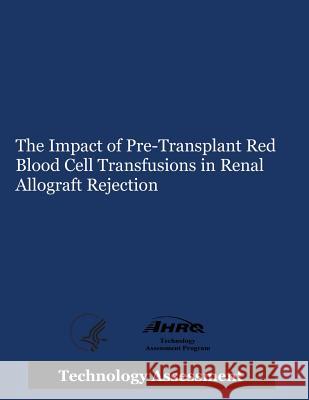The Impact of Pre-Transplant Red Blood Cell Transfusions in Renal Allograft Rejection » książka
The Impact of Pre-Transplant Red Blood Cell Transfusions in Renal Allograft Rejection
ISBN-13: 9781503222366 / Angielski / Miękka / 2014 / 162 str.
Over 450,000 patients in the U.S. have end stage renal disease (ESRD). There are important morbidity and survival advantages to receiving renal transplantation versus dialysis. Human leukocyte antigens (HLA) are a set of human major histocompatibility complex derived glycoproteins that are expressed on cell surfaces and allow for discrimination of self from non-self. HLA have been classified into two major groups, Class I (HLA-A, HLA-B, and HLA-C) and Class II (HLA-DP, HLA-DQ, and HLA-DR). Recognition of the antigens displayed by the transplanted organ (alloantigen) is the prime event initiating the immune response against an allograft. Hyperacute rejection is an immediate recipient immune response against an allograft due to preformed recipient antibodies directed against the donor's HLA. Acute rejection is a cell mediated process that generally occurs within 5 to 90 days after a transplant, although it can rarely occur after this time. Outside of the hyperacute rejection state, humoral rejection can still occur although less frequently than cell mediated acute rejection. Humoral rejection is characterized by B lymphocytes injuring the allograft through immunoglobulin and complement activities. The definition of chronic rejection is ambiguous, and is sometimes recognized as chronic allograft nephropathy or any immunological responses that results in slow loss of graft function with histopathological processes: tubular atrophy, interstitial fibrosis, and fibrous intimal thickening of arteries. There have been major advances in immunosuppressive therapy. Immunosuppressive therapy is broken into three categories: induction therapy, maintenance therapy, and treatment of acute rejection episodes. A major advance was the use of cyclosporine and newer immunosuppressants occur in the mid 1980s and early 1990s. High-volume use of blood transfusion was originally used in attempts to maintain ESRD patients who were anemic with red cell mass ranges of 20-25 percent. Due to concerns with transfusion-induced infections such as hepatitis and the production of anti-HLA antibodies resulting from the exposure to blood products, efforts were made in the 1970s to avoid the use of blood transfusions in renal transplant recipients. During the pre-cyclosporine era, studies suggested that non-transfused renal graft recipients were at higher risk for graft rejection as compared to those transfused recipients. Subsequently, many studies attempted to define the optimal dose and timing for the transfusion effect. With the introduction of cyclosporine in the early 1980s, leading to improved renal graft and patient survival, the beneficial role of blood transfusions and HLA matching was again being questioned. Meanwhile, some preliminary trials had shown the use of matched pretransplant blood transfusion or donor-specific transfusion (DST) to be beneficial. The evidence supporting the effects (positive, negative, neutral) of pretransplant blood transfusion, regardless of therapeutic or protocol transfusion, in renal transplantation is still not well-established. It is unclear whether the benefits, if any, of pre-transplant blood transfusion may be due to the modulation of immune response in which tolerance is induced. This Technology Assessment evaluated data on the impact of red blood cell transfusions on renal allograft outcomes.











